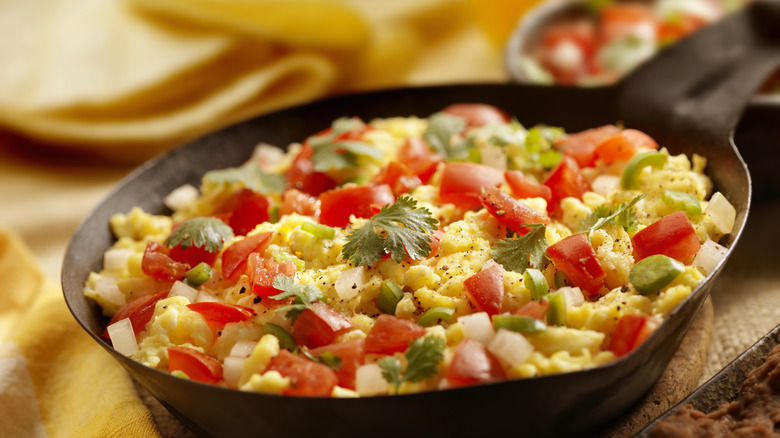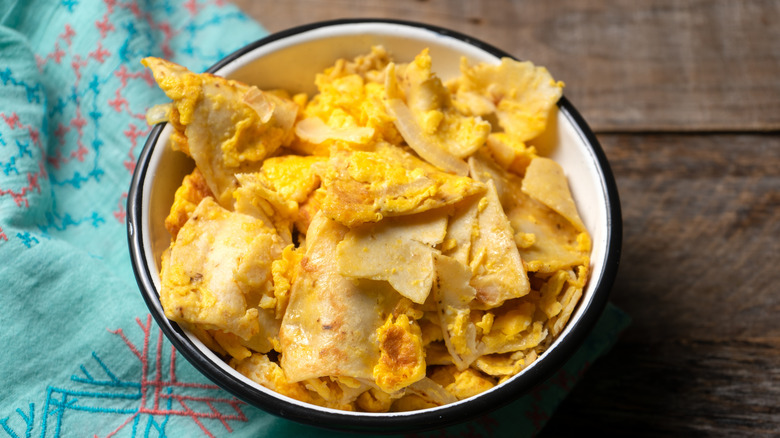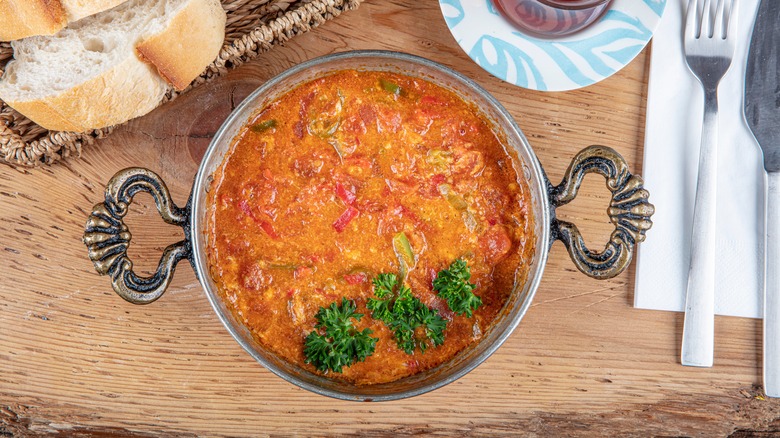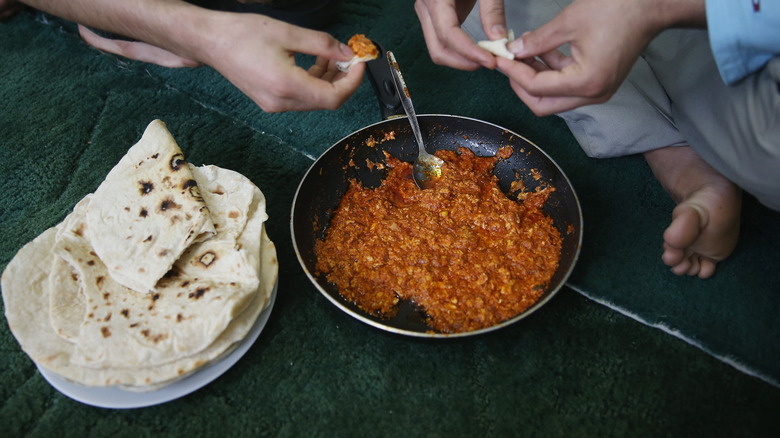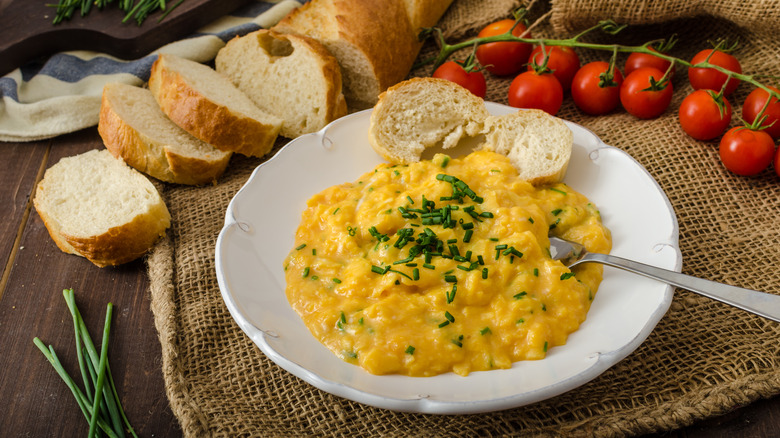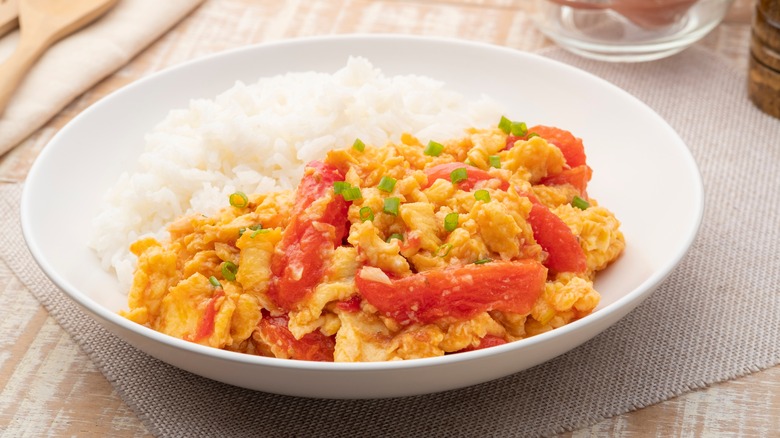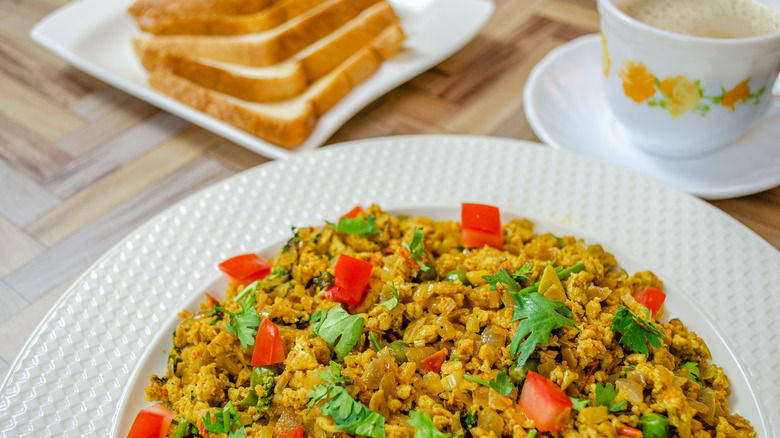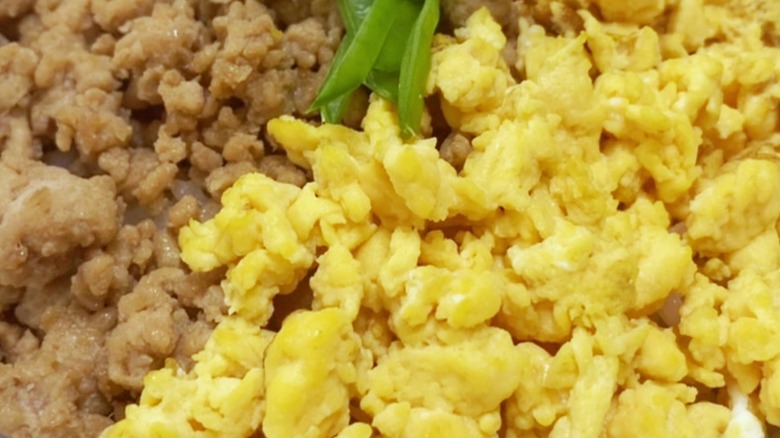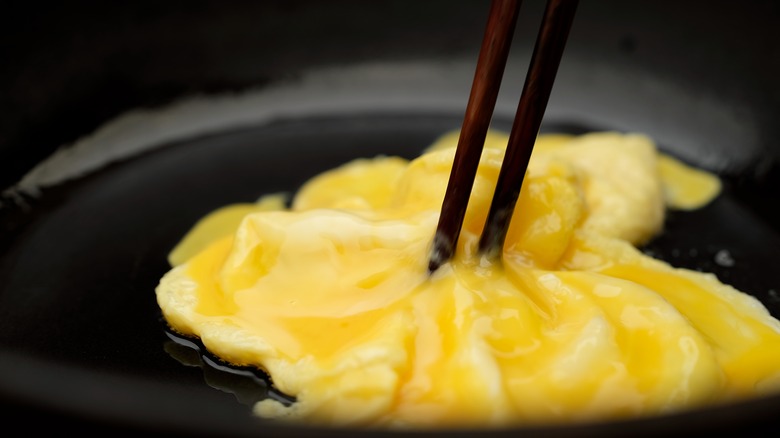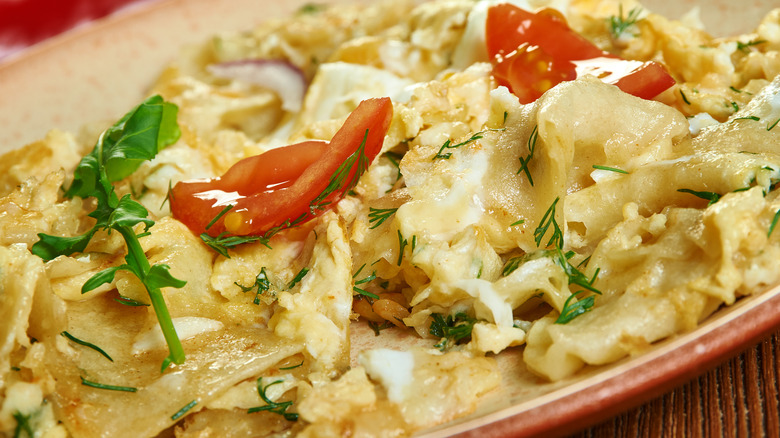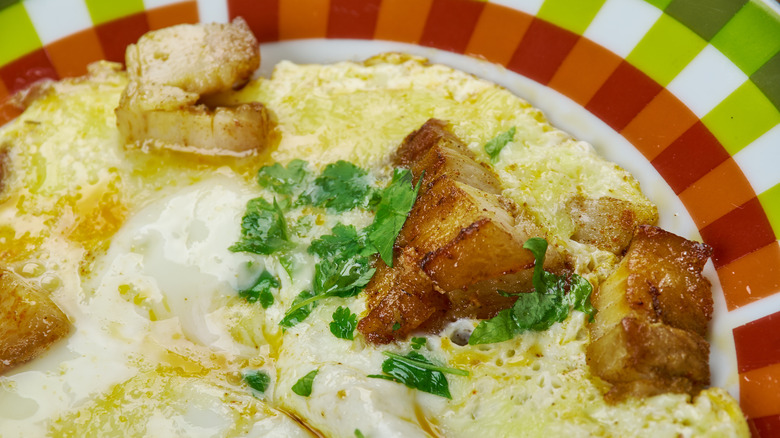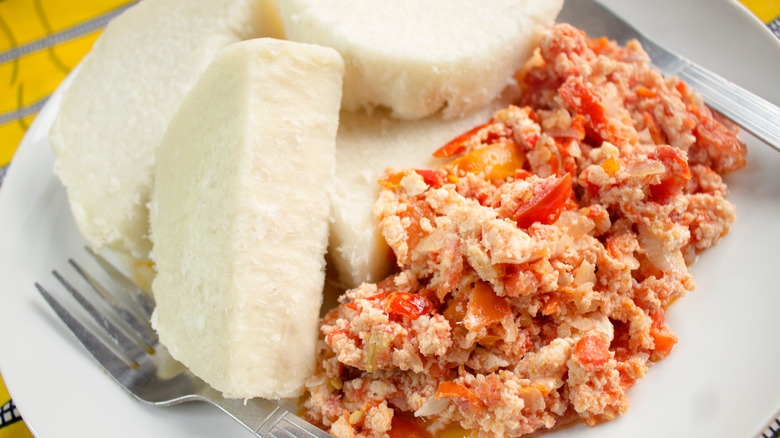From Migas To Tamago: How The World Eats Scrambled Eggs
Few dishes are as familiar and comforting to American diners as a basic plate of hot, fluffy scrambled eggs. Whether you enjoy them with toast, hash browns, or a sauce such as ketchup or hot sauce, there's a good chance that the sight of the familiar favorite evokes memories of cozy childhood breakfasts at home or leisurely mornings at your neighborhood diner. Indeed, scrambled eggs are such an established part of the American breakfast menu that it's nearly impossible to find a place that serves breakfast but doesn't offer them. You can even find them in the pre-made sandwiches in the hot box at your local gas station, albeit mass produced somewhere offsite.
But, scrambled eggs aren't just an American breakfast standby: They're the world's comfort food, and not just for breakfast. Easy and inexpensive to make as well as endlessly versatile, scrambled eggs lend themselves to a wide range of flavorings and presentations, from simple and delicate to hearty and loaded with spice. This has inspired cooks around the world to put their own spin on the basic scramble by incorporating regional and cultural ingredients and seasonings. If you're getting a bit tired of the same, plain scrambled eggs, here are some surprising and flavorful variants to make your next breakfast, brunch, or casual supper truly memorable.
Huevos a la Mexicana
If you enjoy eating your scrambled eggs with salsa, this classic Mexican preparation will become your new favorite. Its name translates simply as "Mexican eggs," and while Mexican cuisine boasts dozens of flavorful egg recipes, this dish exemplifies Mexican cooking at its best basics. It's nothing more than eggs scrambled with the ingredients of a standard pico de gallo — chopped tomatoes, onions, jalapeños, and cilantro. The dish's name comes not just from how elemental these ingredients are to Mexican cooking, but also from the fact that they showcase the vibrant red, green, and white of the Mexican flag.
One reason why this is such a beloved dish in Mexico is that it's super easy to make with readily available ingredients. All you have to do is sauté the tomatoes, onion, and jalapeños in a little oil until soft, then stir in beaten eggs and cilantro and cook to your liking. Serve with warm tortillas on the side or wrap in a big flour tortilla for a quick breakfast burrito.
Migas
Tortillas are an essential element of Mexican cuisine. Over the years, frugal cooks have invented delicious ways to make use of even stale and broken ones. A fun and hearty way to enjoy bits and pieces of old tortillas, for instance, is migas (Spanish for "crumbs"), in which crisp-fried corn tortilla strips are scrambled with eggs, veggies, and cheese and optionally topped with salsa and sliced avocados. While originally devised as a way to keep old tortillas from going to waste, migas is so tasty that many cooks now crisp fry fresh tortilla strips to get their fix.
Dishes of fried tortilla bits cooked with flavorful add-ins are sometimes referred to as chilaquiles, and some cooks, especially in South Texas, use the terms migas and chilaquiles interchangeably. But, food historians and purists insist they are indeed two distinct dishes. Chilaquiles are technically made with bigger pieces of fried tortilla — essentially tortilla chips — tossed with sauce and sometimes other add-ins such as meat. Migas are made with smaller strips of tortillas scrambled with eggs. So, if you're after scrambled eggs, you're looking for migas, but don't be surprised to find eggs in your dish if you order chilaquiles, either.
Turkish menemen
Turkey is celebrated for its vibrantly seasoned, vegetable-forward dishes, and menemen, a favorite breakfast dish consisting of scrambled eggs with hot peppers, tomatoes, onion, and spices such as paprika and oregano, exemplifies the cuisine's flair for making ordinary ingredients into something special.
While the ingredients are similar to those of huevos a la Mexicana, menemen has a distinctly different look and vibe: While huevos a la Mexicana consists of scrambled eggs with vegetables tossed in, menemen is more like a slow-simmered vegetable stew with a few beaten eggs stirred in as a binder. And, instead of using ultra-hot jalapeños as a flavor accent, menemen features a generous portion of sliced and slow-cooked thin-skinned, medium-hot peppers (such as shishitos) to add texture, flavor, and warmth. By tradition, the eggs are softly cooked (with some streaks of egg white still visible) to give the dish its characteristically moist texture. Menemen makes for a hearty and nutritious breakfast on its own, but if you're craving something even more substantial, it's often served with Turkish cured meats such as basturma (salty cured meat similar to pastrami).
Khagina
Cooks around the world love to scramble eggs with veggies, and khagina — a home cooking specialty of Afghanistan and Pakistan — is another flavorful example of this. It's also a case study in how cooks around the world can take nearly identical ingredients and turn them into completely different dishes. Besides eggs, khagina features the now-familiar combo of tomatoes, onions, and hot chiles, but also a copious amount of butter for richness and spices such as cumin and cilantro for additional seasoning.
Like many other scrambled egg dishes, it's well loved not only for its flavor but because it's fast and easy to make. First, chopped onions are sauteed until lightly browned in a generous portion of butter, then whole cumin seeds are added and fried until they release their aroma. Chopped tomatoes are then added and cooked until soft before the eggs, chile, and cilantro are swirled in. While traditionally served with flatbreads such as roti for breakfast, there's no reason not to enjoy it for lunch or dinner, as well.
Oeufs brouillés
Sometimes, recipes that appear to be simple and minimalist can be especially rewarding to eat because they remind us of the fundamental deliciousness of their core ingredients. But, they can also be the most challenging for cooks to master because there's no room to hide mistakes — if you mess up, you can't add more ingredients to cover things up without ruining the dish, or at the very least, transforming it into something completely different.
A case in point is oeufs brouillés, or French-style scrambled eggs. What really makes these eggs special is their unapologetic richness. Rather than enlivening plain scrambled eggs with colorful add-ins and bold seasonings, French cooks enrich their scrambles with generous lashings of cream and butter. They also cook their eggs with care, simmering them slowly over low heat while stirring constantly. This lends them an exceptionally creamy texture with small, soft curds. Served over toasted baguette slices with a garnish of chopped chives, oeufs brouillés make for an elegant breakfast. They're not hard to make, but they do take time and attention, so plan to spend some extra time at the stove when you make them. These eggs will be well worth the wait.
Chinese eggs and tomatoes
By sheer coincidence, cooks around the world have converged on tomatoes as an ideal partner for scrambled eggs. Maybe this is because the tartness and cheery color of tomatoes offer a tasty, pretty contrast to the creamy eggs. Or, perhaps it's because they both cook up quickly, making them easy to cook together. Whatever the reason, tomatoes have found their way into a diverse range of scrambled egg dishes, each with its own unique flair.
One stand-out version is Chinese stir-fried tomatoes and eggs. One defining feature is that this dish is traditionally served for lunch or dinner, rather than for breakfast. Another is that the tomatoes — which are cut into large chunks or slices, rather than chopped — and eggs are stir-fried separately and then combined. Finally, the scramble's other flavorings of fresh ginger, scallions, sesame oil, and Shaoxing wine are not something non-Chinese diners may expect in their eggs. But, they're delicious, and this scramble, along with a bowl of hot rice, makes for an easy and comforting meatless meal.
Motta thoran (South Indian scrambled eggs with coconut)
For North American diners, coconut is either a dessert ingredient or an occasional player in international dishes. In South Asia, coconut is a dietary staple and makes regular appearances in a far more varied range of dishes. A favorite type of preparation in South India is a thoran, or stir-fry that includes shredded coconut seasoned with cumin, turmeric, mustard seeds, curry leaves, and chilis. This versatile preparation can be made with almost any kind of vegetable and sometimes other ingredients, making it handy for home cooks trying to make use of what's on hand.
Eggs are among the many ingredients that take well to the thoran treatment. Motta thoran, or egg thoan, is basically eggs scrambled with seasoned coconut. To make it, mix shredded coconut with ground cumin and set aside. Sauté chopped onions and chiles, then stir in turmeric, salt, and beaten eggs. Once the eggs are about halfway cooked, toss in the coconut and continue cooking. Enjoy this unique and flavorful take on scrambled eggs with rice or flatbreads.
Iri tamago
Experienced cooks know that just a few tiny tweaks in ingredient choice or cooking technique can turn a familiar dish into something completely different. Because they're fundamentally so neutrally flavored, scrambled eggs can be and have been taken in wildly different directions by cooks around the world.
Japanese-style scrambled eggs, or iri tamago, look pretty much like our familiar diner scrambled eggs, albeit a bit firmer with almost crumbly curds. What sets this dish apart is its flavor and texture. The curds of iri tamago are tender but not puffy since Japanese cooks by custom are mindful not to whip air into their eggs when beating them (instead, they are slowly stirred with chopsticks until the whites and yolks are blended). As the eggs are scrambled, they are broken up into small pieces rather than left as a solid mass. Finally, the eggs themselves are packed with hidden flavor. While in some versions the beaten eggs are flavored with mirin (sweet Japanese wine) and sugar, others flavor the eggs with an umami-rich kombu (kelp) and shellfish stock. While most scrambled eggs are only enjoyed hot off the stove, ire tamago is also enjoyed at room temperature, making it a rare, make-ahead scrambled egg dish.
Korean scrambled eggs and rice
Rules, as our contrarian friends often say, are meant to be broken. Or, more precisely, different rules apply in different contexts, especially when it comes to culture. Consider, for instance, the standard wisdom most American home cooks assume when cooking scrambled eggs: First, beat the eggs so the whites and yolks are fully combined with no unsightly streaks of white persisting. Second, stir the eggs constantly as you cook them to get a big, fluffy mass of uniform curds.
But, to make scrambled eggs the right way in Korea, throw all of these rules out the window. Instead of beating the eggs until uniform before cooking, you crack them directly into the cooking pan, just as if you were making fried eggs. (You'll be cooking the eggs in a small quantity of sesame oil to give them a distinctive nutty flavor.) Next, scramble just the whites of each egg using a pair of chopsticks, leaving the yolks intact. Once the whites have cooked, turn off the heat and drizzle the eggs with soy sauce. Finally, break up the yolks, stir them into the whites and soy sauce, and let them sit for a minute to cook in the pan's residual heat. Serve immediately over a bowl of hot rice for a quick and flavorful breakfast.
Matzo brei
The mild, neutral flavor of scrambled eggs makes them a great medium for showcasing other ingredients, and a classic example of this is the Ashkenazi Jewish favorite matzo brei. While matzo brei translates literally as "fried matzo," in reality, the dish consists of lightly moistened shards of matzo scrambled with eggs. While it's a popular breakfast dish year round, it's especially welcomed during Passover, when observant Jews avoid eating leavened bread and rely instead on matzo for their carb cravings.
At its most basic, matzo brei is mild-mannered comfort food. It can be made either sweet or salty — for a sweet version, add sugar to the eggs before cooking them, and for a savory version, add salt and pepper instead and serve the finished dish with sour cream and applesauce. Less-traditional variations abound, as well, and creative cooks have devised versions embellished with ingredients ranging from caramelized bananas to avocados and cheese. If you think traditional matzo brei sounds a bit bland, you might want to give one of these variations a try.
Hangtown fry
Hangtown fry, a regional specialty of Northern California, is little known outside of its home state, which is a shame. It's not only a uniquely bold and flavorful take on scrambled eggs, but it comes with a colorful origin story — or, a combination of origin stories that each may or may not be true. What is known for sure is that it originated in the 19th century in the mining town of Placerville, a community that became notorious during California's gold rush for the large number of hangings that took place there. The components of the dish — chopped bacon and breaded oysters cooked in bacon fat before being folded into scrambled eggs and finished with a touch of hot sauce — are not in dispute. Neither is the fact that the dish is delicious and filling, especially after a hard day of panning for gold.
But, who invented the dish and why are matters of dispute. The dish's key ingredients (bacon and oysters) were considered luxuries in the Old West, and some versions of the origin story claim it was invented by a lucky miner who'd struck it rich and was able to afford these treats. Another story claims that the dish got its name because it was requested by a condemned convict for his last meal. In either case, it's an intriguing bit of history that's well worth tasting.
Nigerian egg stew
This Nigerian dish might differ from what American diners think of when they hear "stew," as it's actually a spicy, colorful breakfast scramble of eggs and vegetables. Common ingredients include onions, chopped red and green bell peppers, Scotch bonnet chiles, fresh tomatoes or tomato paste, and scallions. Other add-ins that contribute extra flavor can include crushed bouillon cubes (a popular cooking ingredient in Africa) and/or curry powder.
Like many family dishes, Nigerian egg stew comes in many versions, with different cooks preferring their own ways of making it. Some recipes call for the veggies to be pureed before being simmered and folded into the eggs, while other cooks simply chop the veggies and sauté them before adding the eggs. In either case, egg stew is traditionally enjoyed with fried or boiled plantains, boiled yams (the starchy, white African variety as opposed to the sweet, yellow American type), cooked potatoes, or a combination of these ingredients to create a hearty breakfast. And, like other scrambled egg dishes, it also makes for a great vegetarian dinner dish, especially with all the hearty root veggies on the side.


